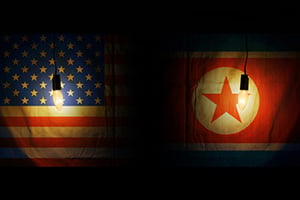 The North Korean nuke threat and the ongoing mess in the South China Sea are helping fuel a staggering "Asian Arms Race" that the Pentagon doesn't want us to know about.
The North Korean nuke threat and the ongoing mess in the South China Sea are helping fuel a staggering "Asian Arms Race" that the Pentagon doesn't want us to know about.
Various technological advancements are being made in Pyongyang right now that could potentially impart devastating blows on American soil.
For example, North Korea now harnesses the power of hypersonic weapons that could deliver nukes far more accurately than typical ICBMs.
But every time the "Hermit Kingdom" tests a missile or makes an ominous threat against the United States, our Strategic Command (STRATCOM) department - a segment of the Pentagon - reacts dismissively.
Take the North Korean missile launch on Feb. 11 that coincided perfectly with Japanese Prime Minister Shinzo Abe's recent visit to Washington. That particular test was made no less than two days after President Donald Trump said that defending against North Korea's nuke and missile tests was a "very, very high priority" of his.
But STRATCOM reduced Pyongyang's show of aggression down to a pesky fly buzzing in America's ear...
Don't Miss: Five Double-Digit Dividend Plays to Secure Your "Second Salary"
"The missile was tracked over North Korea and into the Sea of Japan," the agency said on Feb. 12. "The North American Aerospace Defense Command determined the missile launch from North Korea did not pose a threat to North America."
And that was that.
Here's the catch...
Money Morning Executive Editor William Patalon, III, believes STRATCOM's statement wasn't exactly "the whole truth." And Patalon would know - he's been covering and studying developments within the "Asian arms race" for nearly three decades. Patalon understands how and where to identify potential profit opportunities in the defense manufacturing sector across the Pacific.
And he also knows that neither investors nor politicians should take North Korea for a child playing with its toys...
North Korea Shocked the U.S. Last Year with Nuke Power
Patalon wasn't just concerned about STRATCOM's dismissal of North Korea's threat; he was appalled to learn that Pyongyang's latest launch involved advanced, as-of-yet-unseen technology.
A development about which Uncle Sam just can't afford to be complacent...
[mmpazkzone name="end-story-hostage" network="9794" site="307044" id="138536" type="4"]
Patalon says one reason for Washington's apathy toward NK's missile launches might have manifested from the kingdom's repetitive threatening behavior. "These missile tests are occurring with increasing frequency," Patalon points out, "92 over the last five years, including 18 in each of the last two years. There's almost a sense that 'these guys keep test-launching missiles - but they still don't have the technology or the range to hit the Mainland U.S.'"
Patalon likens this assumption on the United States' part to someone using the wrong "yardstick" to assess North Korea's threat. "I mean, if Kim Jong-un is able to develop sub-launched ballistic missiles (SLBMs), the 'range' becomes much less of an issue."
That's because SLBMs only require a quick cold pressure boost from a submarine's engines to fling a nuke out into the ocean. And from there, the nuke would travel the rest of the way toward Mainland U.S.A. all by itself.
In a recent article for Private Briefing, Patalon explained to subscribers that it was this precise technology - SLBM advancements - that shocked the Pentagon last August. Washington had not expected to detect cold pressure technology in one of NK's missile tests so soon... if at all.
Editor's Note: Since launching in 2011, Bill Patalon's Private Briefing investment service has given readers 217 double- and triple-digit winners. To subscribe and get Patalon's next pick, click here...
And the Pentagon's ability to be so shocked is another concern in and of itself, since that wouldn't be the case if Washington had consistently been paying better attention to Pyongyang's developments all along.
Now, there's no question that a steep uptick in Asian surveillance is warranted. And that kind of surveillance will require "budgetary and technological momentum," Patalon says, "that needs to happen now."
One current silver lining in the dark cloud that is Asia's arms race is new U.S. President Donald Trump. He seems to grasp the severity of Asia's varying threats.
Consider Trump's $54 billion defense spending budget proposal announced on Feb. 27: Now that North Korea has started incorporating advanced nuclear technology into its missile tests, Trump's hefty sum may not feel so exorbitant and unwarranted anymore.
And there's even good reason to believe the new president intends to allocate a lot of that money to monitoring the Hermit Kingdom's antics. "North Korea is a world menace, it is a world problem" Trump said just after proposing his defense budget proposal sum, "and it has to be dealt with soon."
Bill Patalon couldn't agree more.
The 3 Best Defense Stocks to Buy in 2017: Defense stocks are tied to a huge Unstoppable Trend involving "War, Terrorism, and Ugliness" that unfortunately isn't going away. But these three companies are leading the charge to stop war and prevent suffering - and they present a massive profit opportunity, too...


